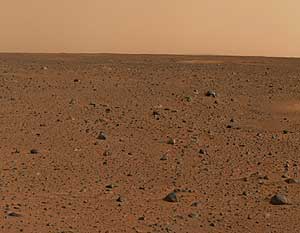|

Color Picture from Spirit is Most Detailed View of Mars Ever Seen(January 6, 2004)The people operating NASA's Spirit have received the first color pictures from the rover and a congratulatory call from the president. President George W. Bush called today to congratulate the rover flight team for reconfirming the American spirit of exploration, said Dr. Charles Elachi, director of NASA's Jet Propulsion Laboratory, Pasadena, Calif., where the mission is managed. Later in the day, the Spirit team awakened the rover with the Mormon Tabernacle Choir's rendition of "Hail to the Chief." Color images in a mosaic released today are the highest-resolution pictures ever sent from Mars, more than three times as detailed as images from Mars Pathfinder in 1997. Spirit's panoramic camera took 12 contiguous frames that the camera team combined into the mosaic. "This is the day we've been waiting for," said Dr. Jim Bell of Cornell University, Ithaca, N.Y., leader of the panoramic camera team. The scene rises from near the edge of Spirit's lander platform to the sky. Scientists are examining every detail to learn about the landing area within Gusev Crater. In one section of particular interest, retraction of the spacecraft's deflated airbags has disturbed the surface. "There are places where rocks were dragged through the soil and the soil was stripped off and folded into bizarre textures," Bell said. Other areas show tails of debris to one side of rocks, possibly shaped by martian winds. "There's a wonderful mix of both smooth and angular rocks near the landing site, and this is something we'll be trying to puzzle out in the next few weeks," he said. Scientists and the public may soon have even more to look at. The panoramic camera mosaic released today shows about one-eighth of a full-circle panorama of the landing region. The camera team plans to have the camera finish taking a full panorama this week. The pictures will share priority with other data during communication sessions either directly from the rover to Earth or relayed via NASA's Mars Global Surveyor and Mars Odyssey orbiters. Engineers are conducting test movements of Spirit's high-gain, direct-to-Earth antenna today to learn more about spikes in the amount of electricity drawn by one of the antenna's motors when the antenna was first used Jan. 4, said JPL's Jennifer Trosper, Spirit mission manager. Meanwhile, the spacecraft will continue using the orbiter relays and its low-gain, direct-to-Earth antenna. The flight team is also finding ways to prevent overheating of electronics inside Spirit. "Our robot geologist was dressed a little warm for the weather on Mars," Trosper said. The atmosphere and surface at the landing site this week are not as cold as anticipated. However, the rover's temperatures are expected to drop when it rolls off its lander platform and gets its wheels onto the ground. Roll-off is now planned no sooner than Jan. 12. One of the next steps in preparing for that event will be to further retract a deflated airbag protruding from under the lander, said JPL's Jessica Collisson, flight director. The team tried out the planned retraction steps on a test rover at JPL. "We're hoping we'll have similar results to what we had in the test bed and we can get that airbag out of the way," Collisson said. Seeing real panoramic camera pictures from Mars, instead of just from tests of the camera inside laboratories or spacecraft assembly areas, put the camera into new perspective for Bell. "Until now, it's been like having an animal in a cage, but now this beast is out, taking incredible pictures in the native habitat it was designed to work in," he said. He praised "the talented and heroic teamwork of people at Cornell and around the country who helped develop this camera -- its optics, filters, electronics." Spirit's twin Mars Exploration Rover, Opportunity, will reach its landing site on the opposite side of Mars on Jan. 25 (EST and Universal Time; Jan. 24 PST). The rovers' task is to explore for clues in rocks and soil about whether the past environments in their landing areas were ever watery and suitable to sustain life. |